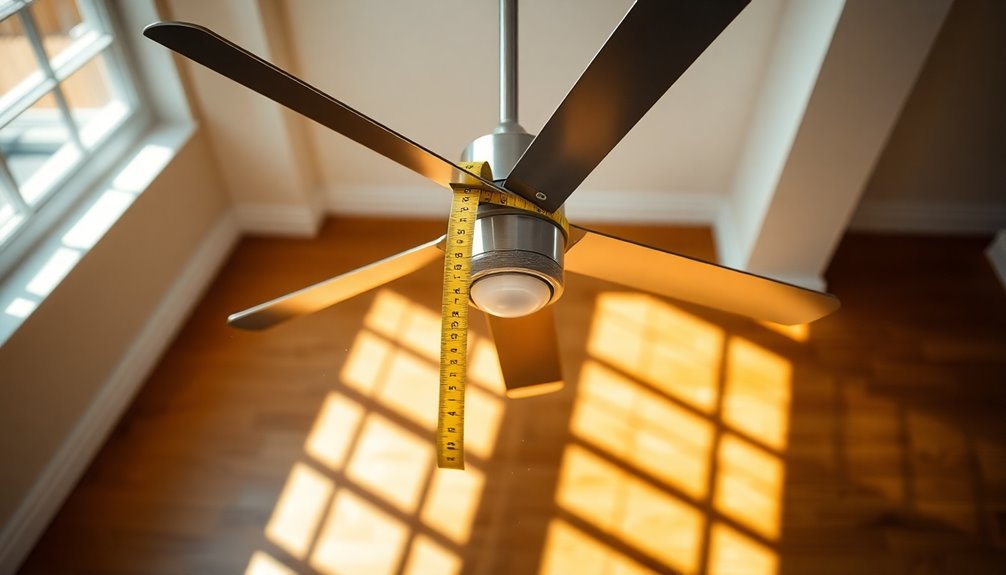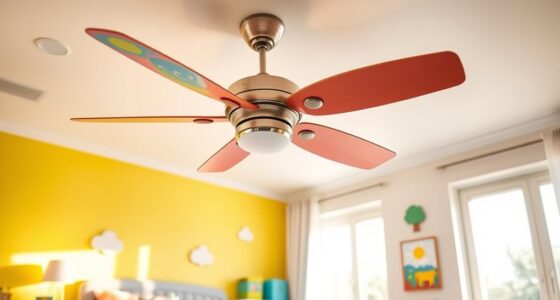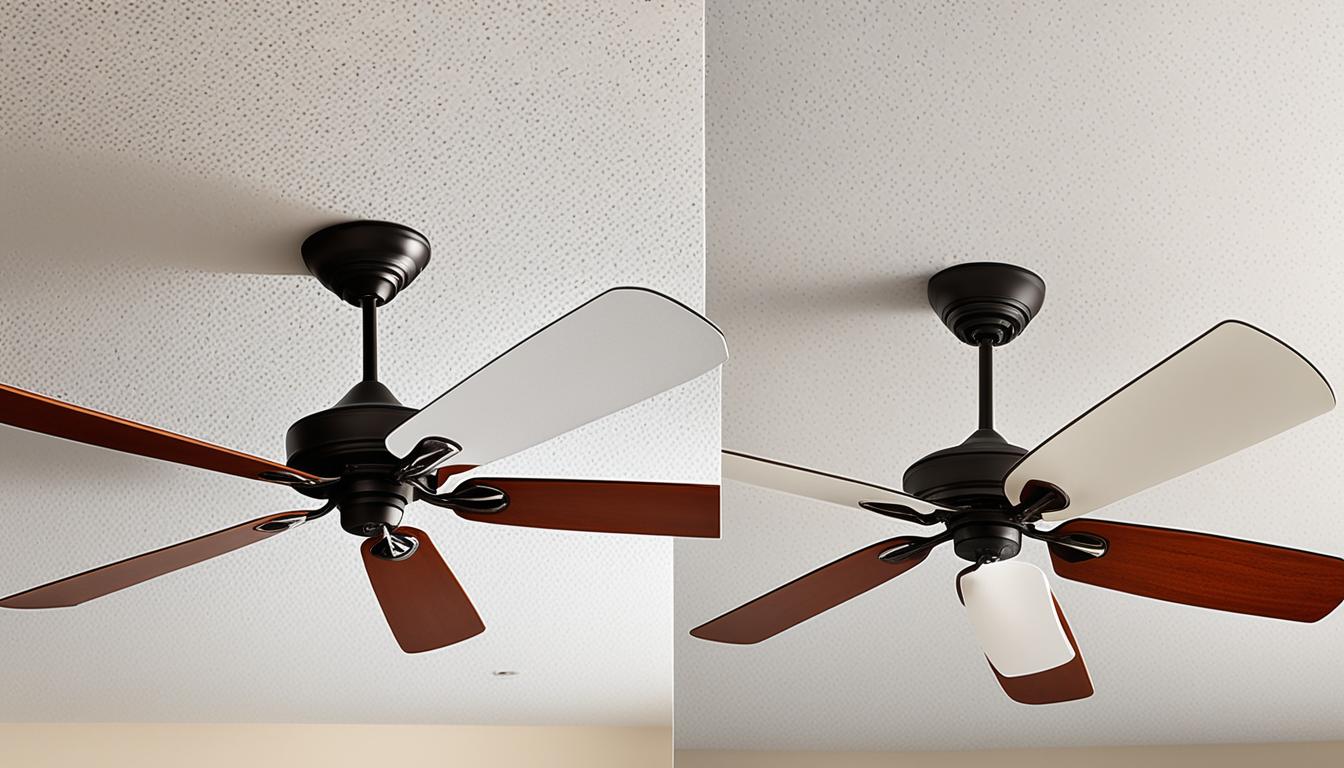To measure ceiling fans accurately, you first need to calculate your room's dimensions. Use a tape measure for length and width, then multiply to find the square footage. For fan size, measure blade span from one tip to the opposite tip; odd-numbered blades will need a different approach. Take into account ceiling height to determine downrod length, ensuring at least 8 inches of clearance. Choose the fan size based on room size: 29-36 inches for small rooms, 36-44 inches for medium, and 52 inches or more for large spaces. There's more to think about for ideal airflow, so keep going!
Key Takeaways
- Ceiling fans are measured by blade span, which is the distance from the tip of one blade to the opposite tip for even-numbered blades.
- For odd-numbered blades, measure from the tip to the center and then double that measurement for the blade span.
- The size of the ceiling fan should match the room size; smaller fans are suitable for rooms up to 75 sq ft.
- Measure ceiling height to determine if a downrod is needed, ensuring fan blades are at least 7 feet above the floor.
- Maintain a minimum of 30 inches clearance between fan blades and walls or other obstructions for optimal air circulation.
Measuring Room Dimensions

To accurately measure your room dimensions, grab a tape measure and start by finding the length and width of the space in feet. Multiply these two measurements to calculate the square footage; for example, a room measuring 10 feet by 12 feet equals 120 square feet.
If you're dealing with an L-shaped room, divide it into two rectangles, measuring each section's length and width before summing their square footage for the total area.
It's essential to account for obstructions or irregular shapes when measuring, as these can affect accurate measurements and fan sizing.
Next, measure the ceiling height from the floor to the highest point in the room. This measurement helps determine the appropriate fan placement and downrod length needed for ideal airflow.
If your ceiling height is less than 8 feet, you'll want to take into account low-profile ceiling fans for adequate circulation. For ceilings of 9 feet or more, fans with downrods are typically necessary to guarantee proper air movement.
Measuring Ceiling Fan Size
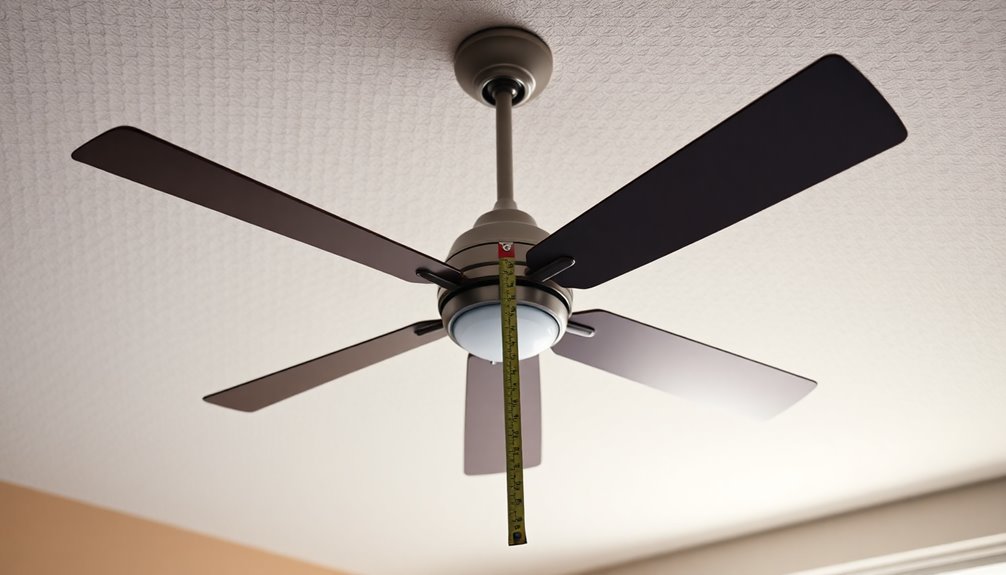
Once you have your room dimensions, measuring the ceiling fan size becomes the next step in guaranteeing ideal airflow.
Ceiling fan size, or blade span, is vital for optimal air circulation. To measure it, find the distance from the tip of one blade to the tip of the opposite blade for even-numbered blades. For odd-numbered blades, measure from the tip to the center and double that measurement.
Common ceiling fan sizes vary based on room size:
- 29-36 inches for small rooms (up to 75 square feet)
- 36-44 inches for medium rooms (76-144 square feet)
- 52 inches or larger for large spaces (over 225 square feet).
It's important to select the right ceiling fan size according to your room's square footage to guarantee effective cooling and air movement.
Additionally, maintain at least 30 inches of clearance between the fan blades and any walls or obstructions. This clearance not only guarantees safety but also enhances the fan's efficiency.
When measuring, make sure the fan is turned off and stationary, and use a ladder if necessary for accurate measurement.
Calculating Downrod Length
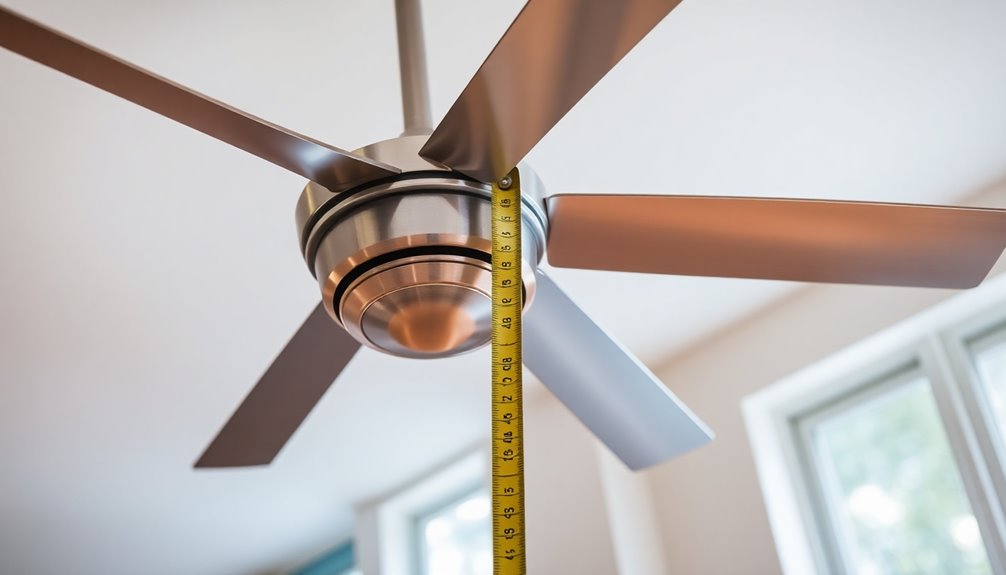
Calculating the downrod length secures your ceiling fan hangs at the perfect height for maximum airflow and safety. To achieve ideal performance, follow these steps:
- Measure your ceiling height. Start by measuring the distance from the floor to the ceiling.
- Subtract the height of the fan. Include the motor and light fixture in this measurement to determine how far the fan will hang.
- Guarantee proper clearance. Maintain at least 8 inches between the ceiling and the fan blades for unobstructed airflow.
- Check manufacturer specifications. Consult charts to find the recommended downrod length based on your ceiling height. For example, with a 10-foot ceiling, you might need a 12-inch downrod to achieve an 8-foot hanging height.
It's vital that the fan blades are positioned at least 7 feet above the floor for safety.
If your ceiling is particularly high, you'll need a longer downrod.
Selecting the Right Fan Size
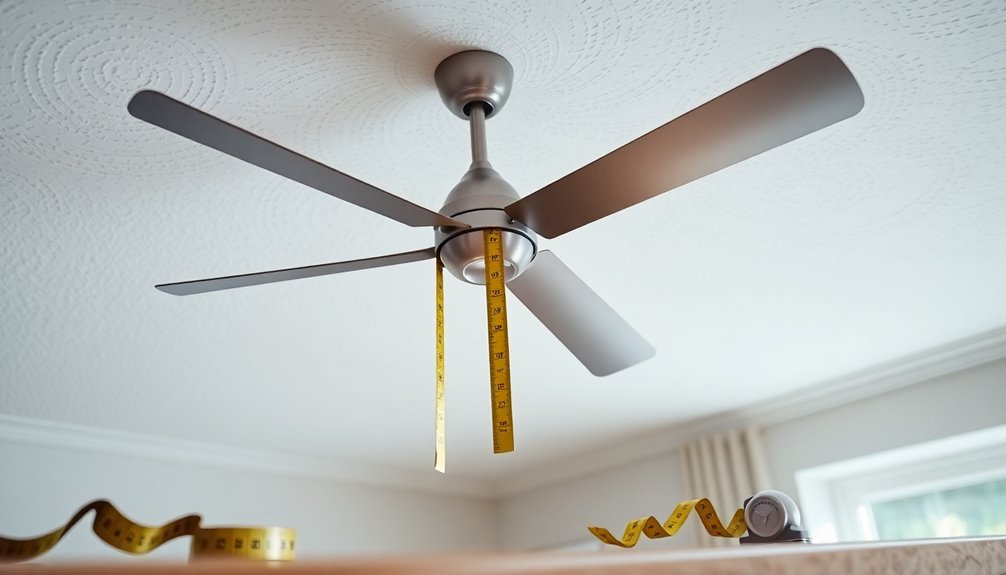
Choosing the right size ceiling fan is just as important as calculating the downrod length for peak performance. To begin, measure the square footage of your room by multiplying its length by width. This measurement guides you in selecting the right fan size.
For small rooms up to 75 square feet, a ceiling fan with a blade span of 29-36 inches is ideal. In medium rooms, ranging from 76-144 square feet, look for a fan with a 36-44 inch blade span. If your room is larger, between 145-225 square feet, a fan with a 44-54 inch blade span is recommended.
For spaces over 226 square feet, consider fans measuring 50-60 inches or larger. If your room exceeds 400 square feet, you might need multiple fans or oversized models with a blade span of 65 inches or more to guarantee effective air circulation.
Remember to maintain a minimum clearance of 30 inches from the fan blades to any walls or obstructions. This clearance is essential for maximum airflow efficiency and comfort in your rooms.
Installation Guidelines and Considerations
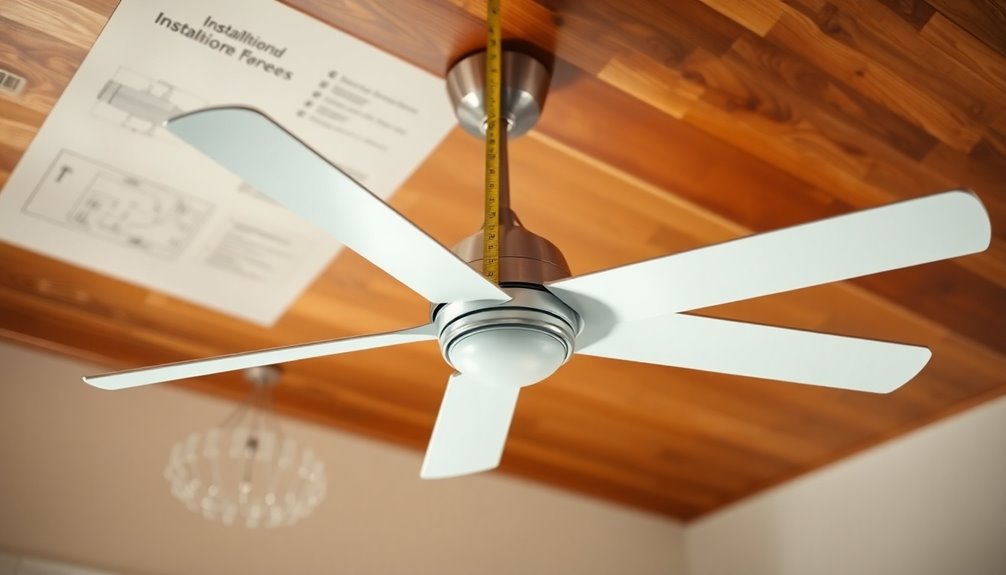
When installing a ceiling fan, it's crucial to confirm that the mounting area can support the fan's weight and that the electrical junction box is rated for ceiling fan use. Following proper installation guidelines guarantees safety and peak performance.
Here are some key considerations:
- Ceiling Height: Install the fan 7 to 9 feet above the floor for effective air circulation and to prevent head impact risks.
- Clearance: Maintain a minimum of 30 inches between the fan blades and walls or other obstructions to enhance airflow and avoid safety hazards.
- Downrod Lengths: Consult the manufacturer's guidelines for recommended downrod lengths based on your ceiling height, confirming the fan hangs at the right height for maximum efficiency.
- Angled Ceiling Mount: If your ceiling has an angle greater than 32 degrees, use an angled ceiling mount adapter to guarantee proper installation and stability while supporting the fan.
Frequently Asked Questions
How Is a 52 Inch Ceiling Fan Measured?
To measure a 52-inch ceiling fan, you'll want to focus on the blade span.
First, turn off the fan for safety. Use a measuring tape to find the distance from one blade tip to the tip of the blade directly opposite.
If your fan has an odd number of blades, measure from one blade tip to the motor's center and double that measurement.
This will give you the accurate size of the fan.
What Does a 44 Inch Ceiling Fan Mean?
Ever wonder what a 44-inch ceiling fan really means? It refers to the diameter of the fan's blade span, measured from one blade tip to the opposite one.
This size is perfect for medium-sized rooms, typically between 145 to 225 square feet, providing just the right amount of airflow.
Plus, it strikes a balance between functionality and style, making it a great fit for various room designs. Just keep that clearance in mind!
Is a 52 Inch Fan Too Big for a 12X12 Room?
Yes, a 52-inch fan is generally too big for a 12×12 room.
It can create excessive air movement, making the space uncomfortable. For ideal airflow and comfort, you should consider a fan with a blade span of 36 to 44 inches.
Using a larger fan might disrupt the room's aesthetic balance, so it's important to think about both size and airflow efficiency when making your choice.
What Size Room Is a 54 Inch Ceiling Fan?
A 54-inch ceiling fan works best in rooms ranging from 225 to 400 square feet.
If your space is about 15 feet by 20 feet, you'll enjoy ideal air circulation.
For larger areas over 400 square feet, consider using multiple fans or larger ones to keep the airflow consistent.
And remember, maintaining at least 30 inches of clearance from the nearest wall is essential for maximizing efficiency and comfort.
Conclusion
Now that you've unraveled the secrets of ceiling fan measurement, you're equipped to create a breeze that dances through your space. Just like a well-composed symphony, the right fan size and placement can harmonize comfort and style in your home. So, go ahead and let your ceiling fan take flight, transforming your room into a rejuvenating oasis. With these guidelines, you're not just installing a fan; you're crafting a cool retreat where every moment feels like a gentle summer's day.
